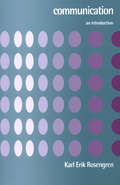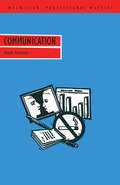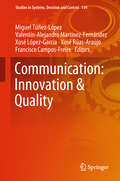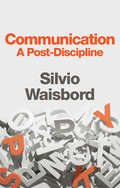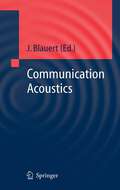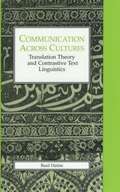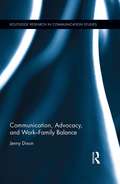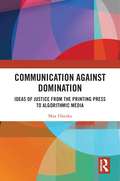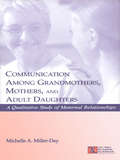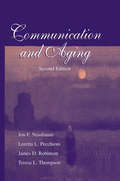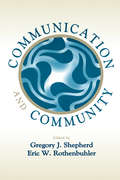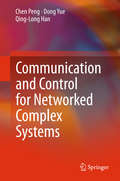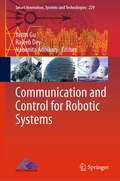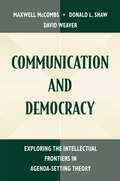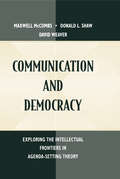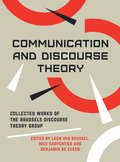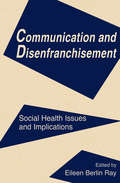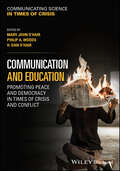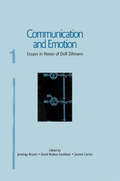- Table View
- List View
Communication: An Introduction (PDF)
by Karl Erik RosengrenWritten as an introduction for beginning students, this book offers a thorough, yet lively, overview of human communication in all its aspects. Accessibly written and assuming no prior knowledge of the discipline Communication: An Introduction: offers a thorough, yet lively, examination of all aspects of human communication, including: a summary of its nature, form and function; a detailed analysis of all the levels of communication; a description and overview of the different traditions of communication studies; and a consideration of the future of communication - as a phenomenon and as a field of research.
Communication
by Nicki StantonPreviously published as "The Business of Communicating", this book aims to help anyone interested in improving their communication skills and their knowledge of the way in which communication functions in business. It is a self-contained book, and also a complement to taught courses.
Communication: Innovation & Quality (Studies in Systems, Decision and Control #154)
by Miguel Túñez-López Valentín-Alejandro Martínez-Fernández Xosé López-García Xosé Rúas-Araújo Francisco Campos-FreireThis book explores the disruptive changes in the media ecosystem caused by convergence and digitization, and analyses innovation processes in content production, distribution and commercialisation. It has been edited by Professors Miguel Túñez-López (Universidade de Santiago de Compostela, Spain), Valentín-Alejandro Martínez-Fernández (Universidade da Coruña, Spain), Xosé López-García (Universidade de Santiago de Compostela, Spain), Xosé Rúas-Araújo (Universidade de Vigo, Spain) and Francisco Campos-Freire (Universidade de Santiago de Compostela, Spain). The book includes contributions from European and American experts, who offer their views on the audiovisual sector, journalism and cyberjournalism, corporate and institutional communication, and education. It particularly highlights the role of new technologies, the Internet and social media, including the ethics and legal dimensions. With 30 contributions, grouped into diverse chapters, on information preferences and uses in journalism, as well as public audiovisual policies in the European Union, related to governance, funding, accountability, innovation, quality and public service, it provides a reliable media resource and presents lines of future development.
Communication: A Post-Discipline (Handbooks In Communication And Media Ser. #29)
by Silvio WaisbordCommunication studies is a fragmented field. As a result of its roots in various disciplinary traditions, it is built on fluid intellectual boundaries with no theoretical or analytical center. Should we worry about this state of dispersion or be concerned that the discipline does not meet the basic conditions that define an academic field of inquiry? Silvio Waisbord argues that communication studies is a post-discipline and that it is impossible to transcend fragmentation and specialization through a single project of intellectual unity. What brings communication studies together is an institutional architecture of academic units, professional associations, and journals, rather than a shared commitment to a common body of knowledge, questions, and debates. This should not, Waisbord argues, be a matter of concern. Communication studies is better served by recognizing dispersion, embracing pluralism, fostering cross-cutting lines of inquiry, and tackling real-world problems, rather than hoping to meet conditions which would qualify it as a discipline. Communication: A Post-Discipline is important reading for scholars and advanced students of communication studies, as well as anyone interested in the state of this fascinating and vital academic field.
Communication Acoustics
by Jens BlauertCommunication Acoustics deals with the fundamentals of those areas of acoustics which are related to modern communication technologies. Due to the advent of digital signal processing and recording in acoustics, these areas have enjoyed an enormous upswing during the last 4 decades. The book chapters represent review articles covering the most relevant areas of the field. They are written with the goal of providing students with comprehensive introductions. Further they offer a supply of numerous references to the relevant literature. Besides its usefulness as a textbook, this will make the book a source of valuable information for those who want to improve or refresh their knowledge in the field of communication acoustics – and to work their way deeper into it. Due to its interdisciplinary character Communication Acoustics is bound to attract readers from many different areas, such as: acoustics, cognitive science, speech science, and communication technology.
Communication Across Cultures: Translation Theory And Contrastive Text Linguistics (Exeter Language And Lexicography Ser. (PDF))
by Basil HatimWhile the literature on either contrastive linguistics or discourse analysis has grown immensely in the last twenty years, very little of it has ventured into fusing the two perspectives. Bearing in mind that doing discourse analysis without a contrastive base is as incomplete as doing contrastive analysis without a discourse base, the specific aim of this book is to argue that translation can add depth and breadth to both contrastive linguistics as well as to discourse analysis. Authentic data from both spoken and written English is used throughout to add clarity to theoretical insights gained from the study of discourse processing. Each aspect of the model proposed for the analysis of texts is related separately to a problem of language processing and in domains as varied as translation, interpreting, language teaching etc. The global objectives pursued in this volume are the training of future linguists and the sensitization of users of language in general to the realities of discourse.
Communication, Advocacy, and Work/Family Balance (Routledge Research in Communication Studies)
by Jenny DixonThis book presents an understanding of work-family balance for working adults belonging to a number of different family structures (e.g. single and/or childfree adults, LGBT couples, families with female breadwinners). It contends that family structure should serve as a way of thinking about diversity (i.e., race, gender, age, family) in the U.S. workplace. It also argues that—in addition to accommodations occurring through workplace policy—the negotiation of work-family balance happens as a result of self-advocacy that occurs in everyday communication about family at work. Relaying the stories of a number of different working adults belonging to a variety of different family structures, it explores the range of obstacles faced in the attempt at balancing work and family life, generates informed ideas for eliminating barriers commonly experienced in balancing work and family, and problematizes enduring assumptions regarding gender roles and the myth of steadfast public and private spheres.
Communication, Advocacy, and Work/Family Balance (Routledge Research in Communication Studies)
by Jenny DixonThis book presents an understanding of work-family balance for working adults belonging to a number of different family structures (e.g. single and/or childfree adults, LGBT couples, families with female breadwinners). It contends that family structure should serve as a way of thinking about diversity (i.e., race, gender, age, family) in the U.S. workplace. It also argues that—in addition to accommodations occurring through workplace policy—the negotiation of work-family balance happens as a result of self-advocacy that occurs in everyday communication about family at work. Relaying the stories of a number of different working adults belonging to a variety of different family structures, it explores the range of obstacles faced in the attempt at balancing work and family life, generates informed ideas for eliminating barriers commonly experienced in balancing work and family, and problematizes enduring assumptions regarding gender roles and the myth of steadfast public and private spheres.
Communication Against Domination: Ideas of Justice from the Printing Press to Algorithmic Media
by Max HänskaThis book tackles the philosophical challenge of bridging the gap between empirical research into communication and information technology, and normative questions of justice and how we ought to communicate with each other. It brings the question of what justice demands of communication to the center of social science research. Max Hänska undertakes expansive philosophical analysis to locate the proper place of normativity in social science research, a looming subject in light of the sweeping roles of information technologies in our social world today. The book’s first section examines metatheoretical issues to provide a framework for normative analysis, while the second applies this framework to three technological epochs: broadcast communication, the Internet and networked communications, and the increasing integration of artificial intelligence and machine learning technologies into our communication systems. Hänska goes beyond the prevailing frameworks in the field by exploring how we answer normative questions and how our answer can change depending on our social context and the affordances of prevailing communications technologies. This book provides an essential guide for scholars as well as graduate and advanced undergraduate students of research and theory in communication, philosophy, political science, and the social sciences.
Communication Against Domination: Ideas of Justice from the Printing Press to Algorithmic Media
by Max HänskaThis book tackles the philosophical challenge of bridging the gap between empirical research into communication and information technology, and normative questions of justice and how we ought to communicate with each other. It brings the question of what justice demands of communication to the center of social science research. Max Hänska undertakes expansive philosophical analysis to locate the proper place of normativity in social science research, a looming subject in light of the sweeping roles of information technologies in our social world today. The book’s first section examines metatheoretical issues to provide a framework for normative analysis, while the second applies this framework to three technological epochs: broadcast communication, the Internet and networked communications, and the increasing integration of artificial intelligence and machine learning technologies into our communication systems. Hänska goes beyond the prevailing frameworks in the field by exploring how we answer normative questions and how our answer can change depending on our social context and the affordances of prevailing communications technologies. This book provides an essential guide for scholars as well as graduate and advanced undergraduate students of research and theory in communication, philosophy, political science, and the social sciences.
Communication Among Grandmothers, Mothers, and Adult Daughters: A Qualitative Study of Maternal Relationships (LEA's Series on Personal Relationships)
by Michelle A. Miller-DayThis volume examines communication processes within the grandmother-mother-daughter relationship, emphasizing an intergenerational perspective. Using observations of and extensive interviews with six sets of middle-income, Caucasian female family members, this book offers a heuristic account of intergenerational mother-daughter relational communication.Author Michelle Miller-Day integrates and juxtaposes alternative experiences of social interaction, situating readers in the world of grandmothers, mothers, adult daughters, and granddaughters as they experience, describe, and analyze their family communication. Miller-Day incorporates aged mothers and younger mid-life mothers and their adult daughters into the research to illustrate how this type of maternal relationship is experienced at different points in a woman's life. With the inclusion of three generations of women, Miller-Day offers multigenerational perspectives on family, and examines them for patterns of maternal interaction, providing symbolic links across generational boundaries.Communication Among Grandmothers, Mothers, and Adult Daughters enables readers to understand more completely the richly textured nature of maternal relationships. It will be an invaluable resource for scholars and researchers in the areas of communication and relationships, including family communication, intergenerational communication, women's studies, family studies, interpersonal communication, and relationships, as well as social workers, psychologists, and counselors, who strive to understand family communication processes and their dynamics across generational lines.
Communication and Aging (Routledge Communication Series)
by Jon F. Nussbaum Loretta L. Pecchioni James D. Robinson Teresa L. ThompsonThis text employs a communication perspective to examine the aging process and the ability of individuals to adapt successfully to aging. It continues the groundbreaking work of the first edition, emphasizing a life-span approach toward understanding the social interaction that occurs during later life. The edition provides a comprehensive update on the existing and emerging research within communication and aging studies and considers such topics as notions of successful aging, positive and negative stereotypes toward older adults, and health communication issues. It raises awareness of the barriers facing elderly people in conversation and the importance such conversations have in elderly people's lives. The impact of nonrelational processes, such as hearing loss, are considered as they impact relationships with others and affect the ability to age successfully. The book is organized into 14 chapters. Each chapter is written so that the reader is presented with an exhaustive review of the pertinent and recent literature from the social sciences. As in the first edition, when the literature is empirically based, the communicative ramifications are then discussed. Readers of this volume will gain greater understanding of the importance of their communicative relationships and how significant they remain across the life span. Developed for students in communication, psychology, nursing, social gerontology, sociology, and related areas, Communication and Aging provides important insights on communication to all who are affected by the aging process.
Communication and Aging (Routledge Communication Series)
by Jon F. Nussbaum Loretta L. Pecchioni James D. Robinson Teresa L. ThompsonThis text employs a communication perspective to examine the aging process and the ability of individuals to adapt successfully to aging. It continues the groundbreaking work of the first edition, emphasizing a life-span approach toward understanding the social interaction that occurs during later life. The edition provides a comprehensive update on the existing and emerging research within communication and aging studies and considers such topics as notions of successful aging, positive and negative stereotypes toward older adults, and health communication issues. It raises awareness of the barriers facing elderly people in conversation and the importance such conversations have in elderly people's lives. The impact of nonrelational processes, such as hearing loss, are considered as they impact relationships with others and affect the ability to age successfully. The book is organized into 14 chapters. Each chapter is written so that the reader is presented with an exhaustive review of the pertinent and recent literature from the social sciences. As in the first edition, when the literature is empirically based, the communicative ramifications are then discussed. Readers of this volume will gain greater understanding of the importance of their communicative relationships and how significant they remain across the life span. Developed for students in communication, psychology, nursing, social gerontology, sociology, and related areas, Communication and Aging provides important insights on communication to all who are affected by the aging process.
Communication and Community (Routledge Communication Series)
by Gregory J. Shepherd Eric W. RothenbuhlerThis distinctive volume combines synthetic theoretical essays and reports of original research to address the interrelations of communication and community in a wide variety of settings. Chapters address interpersonal conversation and communal relationships; journalism organizations and political reporting; media use and community participation; communication styles and alternative organizations; and computer networks and community building; among other topics. The contents offer synthetic literature reviews, philosophical essays, reports of original research, theory development, and criticism. While varying in theoretical perspective and research focus, each of the chapters also provides its own approach to the practice of communication and community. In this way, the book provides a recurrent thematic emphasis on the pragmatic consequences of theory and research for the activities of communication and living together in communities. Taken as a whole, this collection illustrates that communication and community cannot be adequately analyzed in any context without considering other contexts, other levels of analysis, and other media and modes of communication. As such, it provides important insights for scholars, students, educators, and researchers concerned with communication across the full range of contexts, media, and modes.
Communication and Community (Routledge Communication Series)
by Gregory J. Shepherd Eric W. RothenbuhlerThis distinctive volume combines synthetic theoretical essays and reports of original research to address the interrelations of communication and community in a wide variety of settings. Chapters address interpersonal conversation and communal relationships; journalism organizations and political reporting; media use and community participation; communication styles and alternative organizations; and computer networks and community building; among other topics. The contents offer synthetic literature reviews, philosophical essays, reports of original research, theory development, and criticism. While varying in theoretical perspective and research focus, each of the chapters also provides its own approach to the practice of communication and community. In this way, the book provides a recurrent thematic emphasis on the pragmatic consequences of theory and research for the activities of communication and living together in communities. Taken as a whole, this collection illustrates that communication and community cannot be adequately analyzed in any context without considering other contexts, other levels of analysis, and other media and modes of communication. As such, it provides important insights for scholars, students, educators, and researchers concerned with communication across the full range of contexts, media, and modes.
Communication and Control for Networked Complex Systems
by Chen Peng Dong Yue Qing-Long HanThis book reports on the latest advances in the study of Networked Control Systems (NCSs). It highlights novel research concepts on NCSs; the analysis and synthesis of NCSs with special attention to their networked character; self- and event-triggered communication schemes for conserving limited network resources; and communication and control co-design for improving the efficiency of NCSs. The book will be of interest to university researchers, control and network engineers, and graduate students in the control engineering, communication and network sciences interested in learning the core principles, methods, algorithms and applications of NCSs.
Communication and Control for Robotic Systems (Smart Innovation, Systems and Technologies #229)
by Jason Gu Rajeeb Dey Nabanita AdhikaryThis book is a collection of high-quality research articles. The book includes topics specific to the emerging areas of control for robotic systems, wireless communication, and development of embedded systems for robotic applications. The book integrates three important aspects of automation, namely (i) communication, (ii) control, and (iii) embedded design for robotic applications. This book is unique as it provides a unified framework for analysis, design, and deployment of the robotic applications across various engineering and non-engineering disciplines including the three primary aspects mentioned above. Furthermore, the emerging research and development work pertaining to the deployment of intelligent, nonlinear, and embedded control for robotic system for non-standard operating environment due to the widespread application of robotics technology for societal benefit is also a focal point of the book.
Communication and Democracy: Exploring the intellectual Frontiers in Agenda-setting theory (Routledge Communication Series)
by Maxwell E. McCombs Donald L. Shaw David H. WeaverExciting intellectual frontiers are open for exploration as agenda-setting theory moves beyond its 25th anniversary. This volume offers an intriguing set of maps to guide this exploration over the near future. It is intended for those who are already reasonably well read in the research literature that has accumulated since the publication of McCombs and Shaw's original 1972 Public Opinion Quarterly article. This piece of literature documented the influence of the news media agenda on the public agenda in a wide variety of geographic and social settings, elaborated the characteristics of audiences and media that enhance or diminish those agenda-setting effects, and cataloged those exogenous factors explaining who sets the media's agenda. In the current volume, a provocative set of maps for explicating new levels of agenda-setting theory have been sketched by a new generation of young scholars, launching an enterprise that has significant implications for theoretical research and for the day-to-day role of mass communication in democratic societies. At the first level of agenda setting are agendas of objects--the traditional domain of agenda setting research--represented by an accumulation of hundreds of studies over the past quarter century. At the second level of agenda setting are agendas of attributes--one of the new theoretical frontiers whose aspects are discussed in detail in the opening chapters. Other chapters offer maps of yet other theoretical frontiers, including political advertising agendas and their impact on behavior, the framing of various agendas in the mass media and the differential impact of print and TV, the theoretical role of individual differences in the agenda-setting influence of the news media on the public agenda, methodological advances for determining cause and effect roles in agenda-setting, and the application of agenda-setting theory to historical analysis. This volume is an invitation to others to become active members of the invisible college of agenda-setting scholarship. As such, the goals of this book are threefold: * to introduce a broad set of ideas about agenda-setting; * to enrich the exploration of these ideas by enhancing scholarly dialogue among the members of this invisible college; and * to enhance the discussion of agenda-setting research in seminars and research groups around the world. Agenda-setting has remained a vital and productive area of communication research over a quarter century because it has continued to introduce new research questions into the marketplace of ideas and to integrate this work with other theoretical concepts and perspectives about journalism and mass communication. Understanding the dynamics of agenda- setting is central to understanding the dynamics of contemporary democracy. This book's set of theoretical essays, grounded in the accumulated literature of agenda- setting theory and in the creative insights of young scholars, will help lead the way toward that understanding.
Communication and Democracy: Exploring the intellectual Frontiers in Agenda-setting theory (Routledge Communication Series)
by Maxwell McCombs Donald L. Shaw David WeaverExciting intellectual frontiers are open for exploration as agenda-setting theory moves beyond its 25th anniversary. This volume offers an intriguing set of maps to guide this exploration over the near future. It is intended for those who are already reasonably well read in the research literature that has accumulated since the publication of McCombs and Shaw's original 1972 Public Opinion Quarterly article. This piece of literature documented the influence of the news media agenda on the public agenda in a wide variety of geographic and social settings, elaborated the characteristics of audiences and media that enhance or diminish those agenda-setting effects, and cataloged those exogenous factors explaining who sets the media's agenda. In the current volume, a provocative set of maps for explicating new levels of agenda-setting theory have been sketched by a new generation of young scholars, launching an enterprise that has significant implications for theoretical research and for the day-to-day role of mass communication in democratic societies. At the first level of agenda setting are agendas of objects--the traditional domain of agenda setting research--represented by an accumulation of hundreds of studies over the past quarter century. At the second level of agenda setting are agendas of attributes--one of the new theoretical frontiers whose aspects are discussed in detail in the opening chapters. Other chapters offer maps of yet other theoretical frontiers, including political advertising agendas and their impact on behavior, the framing of various agendas in the mass media and the differential impact of print and TV, the theoretical role of individual differences in the agenda-setting influence of the news media on the public agenda, methodological advances for determining cause and effect roles in agenda-setting, and the application of agenda-setting theory to historical analysis. This volume is an invitation to others to become active members of the invisible college of agenda-setting scholarship. As such, the goals of this book are threefold: * to introduce a broad set of ideas about agenda-setting; * to enrich the exploration of these ideas by enhancing scholarly dialogue among the members of this invisible college; and * to enhance the discussion of agenda-setting research in seminars and research groups around the world. Agenda-setting has remained a vital and productive area of communication research over a quarter century because it has continued to introduce new research questions into the marketplace of ideas and to integrate this work with other theoretical concepts and perspectives about journalism and mass communication. Understanding the dynamics of agenda- setting is central to understanding the dynamics of contemporary democracy. This book's set of theoretical essays, grounded in the accumulated literature of agenda- setting theory and in the creative insights of young scholars, will help lead the way toward that understanding.
Communication and Discourse Theory: Collected Works of the Brussels Discourse Theory Group
by Leen Van Brussel Nico Carpentier Benjamin De CleenDrawing on a variety of case studies, ranging from the politics of reality TV to the representation of populism, Communication and Discourse Theory highlights both the radical contingent nature and the hegemonic workings of media and communication practices.
Communication and Disenfranchisement: Social Health Issues and Implications (Routledge Communication Series)
by Eileen Berlin RayThis volume and its companion case studies book deal with some of the people, groups, and classes who are living a disenfranchised existence in the United States. Whether through birth, life events, or unfortunate circumstances, they are denied full privileges, rights, and power within the existing societal structure. Centered around societal health problems as they relate to socioeconomic status, family, abuse, and health concerns, these volumes examine salient issues from several theoretical frameworks, including feminist theory and the social construction of reality. Communication and Disenfranchisement provides theory-based essays on topics such as the homeless, adult survivors of sexual assault, battered women, persons with disabilities, impoverished women, the indigent living in the inner city, persons with HIV/AIDS, the terminally ill, and the elderly. Case Studies in Communication and Disenfranchisement provides parallel case studies, applying the issues and concepts discussed in the essays. Used together, these books provide theoretically-based applications of social health issues within a communication framework. Traditionally, health communication research has emphasized the communication-physical health relationship. Inadvertently, this primary focus has restricted what information has been included under the domain of health communication. These books expand that domain by examining how the communication-disenfranchisement relationship is accomplished, managed, and overcome, and by recognizing the significance of the pragmatic and theoretic implications of this inquiry.
Communication and Disenfranchisement: Social Health Issues and Implications (Routledge Communication Series)
by Eileen Berlin RayThis volume and its companion case studies book deal with some of the people, groups, and classes who are living a disenfranchised existence in the United States. Whether through birth, life events, or unfortunate circumstances, they are denied full privileges, rights, and power within the existing societal structure. Centered around societal health problems as they relate to socioeconomic status, family, abuse, and health concerns, these volumes examine salient issues from several theoretical frameworks, including feminist theory and the social construction of reality. Communication and Disenfranchisement provides theory-based essays on topics such as the homeless, adult survivors of sexual assault, battered women, persons with disabilities, impoverished women, the indigent living in the inner city, persons with HIV/AIDS, the terminally ill, and the elderly. Case Studies in Communication and Disenfranchisement provides parallel case studies, applying the issues and concepts discussed in the essays. Used together, these books provide theoretically-based applications of social health issues within a communication framework. Traditionally, health communication research has emphasized the communication-physical health relationship. Inadvertently, this primary focus has restricted what information has been included under the domain of health communication. These books expand that domain by examining how the communication-disenfranchisement relationship is accomplished, managed, and overcome, and by recognizing the significance of the pragmatic and theoretic implications of this inquiry.
Communication and Education: Promoting Peace and Democracy in Times of Crisis and Conflict (Communicating Science in Times of Crisis)
by Mary John O'HairA timely and insightful exploration of the vital relationships among effective communication, education, peace, and democracy Communication and Education: Promoting Peace and Democracy in Times of Crisis and Conflict explores the complexities of addressing divisive societal challenges, reducing conflicts, and building and sustaining peace and democracy around the world. Contributions by an international panel of experts provide evidence-based practices, findings from ongoing research projects, policy analyses, and cutting-edge theories, frameworks, and models for confronting global challenges to peace and democracy. Examining the crucial role of crisis communication and education on a global scale, this research-based compendium covers a broad range of key topics, such as democratizing education, promoting peace through complexity science, understanding how factionalism threatens democracy, encouraging citizen participation, and more. Throughout the text, the authors highlight the need for equity, compassion, critical thinking, and active engagement to create a sustainable future based on democratic values. Designed to enhance the knowledge base of crisis communication related to crises impacting education, peace, and democracy, Communication and Education: Explores different strategies and practices for fostering democracy in education, such as the IDEALS framework for creating positive school cultures Discusses emotional geographies in schools and their impact on democratic school climate and teacher burnout Emphasizes empathic communication and participatory skills among teachers Offers practical strategies and examples of harnessing technology for peace and democracy Provides real-world case studies illustrating the transformative power of education, music, diverse perspectives, and open communication channels Examines the ecological interdependence of effective communication, education, democracy and peace Part of the Wiley Blackwell Communicating Science in Times of Crisis series, Communication and Education: Promoting Peace and Democracy in Times of Crisis and Conflict is essential reading for communication and education scholars, researchers, students, practitioners, and community scientists.
Communication and Education: Promoting Peace and Democracy in Times of Crisis and Conflict (Communicating Science in Times of Crisis)
by Mary John O᾿Hair Philip A. Woods H. Dan O᾿HairA timely and insightful exploration of the vital relationships among effective communication, education, peace, and democracy Communication and Education: Promoting Peace and Democracy in Times of Crisis and Conflict explores the complexities of addressing divisive societal challenges, reducing conflicts, and building and sustaining peace and democracy around the world. Contributions by an international panel of experts provide evidence-based practices, findings from ongoing research projects, policy analyses, and cutting-edge theories, frameworks, and models for confronting global challenges to peace and democracy. Examining the crucial role of crisis communication and education on a global scale, this research-based compendium covers a broad range of key topics, such as democratizing education, promoting peace through complexity science, understanding how factionalism threatens democracy, encouraging citizen participation, and more. Throughout the text, the authors highlight the need for equity, compassion, critical thinking, and active engagement to create a sustainable future based on democratic values. Designed to enhance the knowledge base of crisis communication related to crises impacting education, peace, and democracy, Communication and Education: Explores different strategies and practices for fostering democracy in education, such as the IDEALS framework for creating positive school cultures Discusses emotional geographies in schools and their impact on democratic school climate and teacher burnout Emphasizes empathic communication and participatory skills among teachers Offers practical strategies and examples of harnessing technology for peace and democracy Provides real-world case studies illustrating the transformative power of education, music, diverse perspectives, and open communication channels Examines the ecological interdependence of effective communication, education, democracy and peace Part of the Wiley Blackwell Communicating Science in Times of Crisis series, Communication and Education: Promoting Peace and Democracy in Times of Crisis and Conflict is essential reading for communication and education scholars, researchers, students, practitioners, and community scientists.
Communication and Emotion: Essays in Honor of Dolf Zillmann (Routledge Communication Series)
by Jennings Bryant David Roskos-Ewoldsen Joanne CantorThis collection serves two important functions: it synthesizes theory and research in the vital and vibrant area of communication and emotion, and it highlights the scholarly work and contributions of Dolf Zillmann, the preeminent contributor to this area of inquiry.As one of the most productive and influential scholars in the annals of communication inquiry, Zillmann is well known for his contributions in the areas of communication, emotion, media effects, and aggression. Editors Jennings Bryant, David Roskos-Ewoldsen, and Joanne Cantor have collected groundbreaking essays from scholars active in the field, all of whom studied under or worked with Zillmann during his exemplary career. The contributions included here acknowledge the significance of Zillmann's work and identify many of the intellectual streams that contributed to his scholarship.Utilizing both psychology and communication perspectives, this volume covers the current literature in communication and emotion, with a focus on key theories, media effects, and entertainment theory. As a comprehensive synthesis of theory and research in communication and emotion, it will be of great interest to scholars in communication theory, cognitive and social psychology, and psychophysiology. With a concluding state-of-the-art chapter by Dolf Zillmann himself, this volume offers a thorough and distinctive examination of communication and emotion scholarship, and it will serve as an invaluable resource for current and future generations of scholars.
